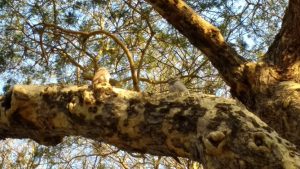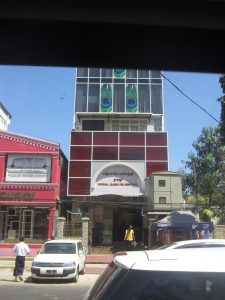While the current political situation (the repression and slaughter of the Rohingya) in Myanmar preoccupied us during preparations for landing in Myanmar, our time there was spent mostly in Bagan, a city in which the historical dominates the contemporary. The Bagan Kingdom ruled most of what is presently Myanmar from the 11th through the 13th centuries. The authoritarian politics of those days are made evident through the extant 2000 or so Buddhist pagodas (reliquary mounds) and temples which they commissioned, dotting the plain all the way to the horizon. (We could see the effect of last year’s earthquake in that many of the spires were being repaired—note the bamboo scaffolding.) These monuments, which required tens of thousands of workers to construct, were built to help the rulers accumulate merit to increase the possibility of a better rebirth or perhaps rebirth in Paradise. Theirs has not been the only patronage at Bagan, however. There is also evidence of less elite patronage in individual tiles that were donated. The practice of individual donation continues today with people affixing gold leaf on the most adored Buddha images and constructing smaller temples with the combined incomes of family members.
This port was special for me as I was given guidance in arranging our travel from my first professor of Art History (at UT Austin), Donald Stadtner (my first Sensei or mentor). While the courses I took from him concentrated on Japanese art, his scholarly focus has long been Burma, which is how he defiantly continues to call it. Don put us in touch with the tour company he uses: Myanmar Shalom, run by an Iraqi-Burmese Jewish family that emigrated from Iraq generations ago and also cares for the lone synagogue in Yangon.
Don’s advice led to a most wonderful sojourn, keeping us out of the highly touristic areas and ensuring we would learn a lot about the sites from the superb guides employed by the company. His tips also led us to the Thande Hotel in Bagan. From the hotel we could view a massive golden pagoda across the Irrawaddy River to the west, one of the many pagodas originally built by King Anawrahta (1044–1077). All of our meals were taken outside under the acacia trees, within a micro-universe of birds, squirrels, geckos and bats (in the evening). There were three owlets, two of whom frequently occupied a hollowed-out burl in the tree. A pair of owls is a symbol of good luck in Myanmar; they certainly reminded us of our own good fortune.
Myanmar is at a crossroads. Given the ferocious devotion to the idea of democracy I witnessed in the people we met, I am confident that it will eventually triumph. I hope to go back to see that victory and its spoils (better roads, better health care, etc.) for myself (and Blake and I would like to bring Jeff next time, who would find Myanmar most interesting).







April 2, 2017 at 5:06 am
I’m enjoying these posts, and am looking forward to the next exciting episode! So glad you got to spend time with the artists in Vietnam.